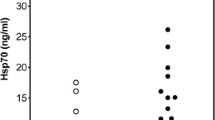Abstract
The overexpression of the heat-shock proteins hsp90, hsp70 and hsp27 in human mammary carcinomas has previously been shown to correlate with reduced overall survival. Moreover, antibodies to hsp90 were detectable in the serum of a large proportion of breast cancer patients but they were not found in normal controls. High antibody levels also correlated with reduced survival. Here, we show that antibodies to hsp27 were also detectable in the sera from breast cancer patients but not from normal controls, whereas antibodies to hsp70 were detectable in approximately one-third of both groups. The presence of antibodies to hsp27 was correlated with an improved rather than a reduced survival, particularly beyond the first 5 years. Hence, the overexpression of hsps in breast cancer cells does not provoke a generalized immune response to all the hsps. Moreover, the presence of antibodies to different hsps has distinct associations with survival. These effects are discussed in terms of the mechanisms that provoke an immune response to the hsps and the protective/non-protective effects of such a response.
Similar content being viewed by others
Author information
Authors and Affiliations
Rights and permissions
About this article
Cite this article
Conroy, S., Sasieni, P., Amin, V. et al. Antibodies to heat-shock protein 27 are associated with improved survival in patients with breast cancer. Br J Cancer 77, 1875–1879 (1998). https://doi.org/10.1038/bjc.1998.312
Issue Date:
DOI: https://doi.org/10.1038/bjc.1998.312
- Springer Nature Limited
This article is cited by
-
Association Between Serum Levels of Anti-heat Shock Protein 27 Antibody and Liver Cell Injury in Chronic Hepatitis B
Indian Journal of Clinical Biochemistry (2023)
-
Serum levels of anti-heat shock protein 27 antibodies in patients with chronic liver disease
Cell Stress and Chaperones (2021)
-
Molecular chaperone Hsp27 regulates the Hippo tumor suppressor pathway in cancer
Scientific Reports (2016)
-
Anti-heat shock protein autoantibody profiling in breast cancer using customized protein microarray
Analytical and Bioanalytical Chemistry (2016)
-
The role of heat shock proteins in bladder cancer
Nature Reviews Urology (2013)




